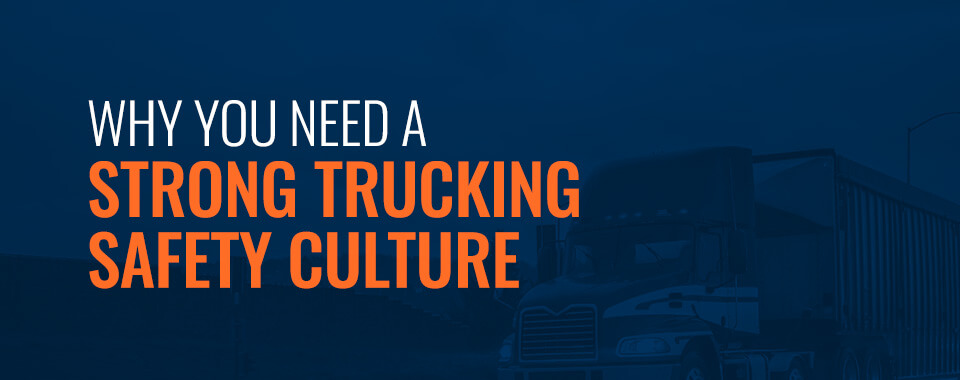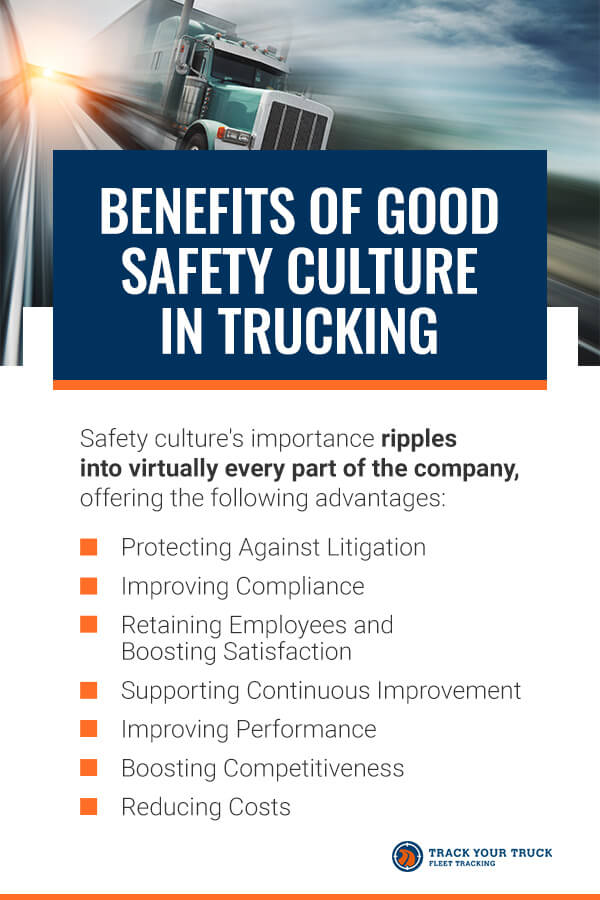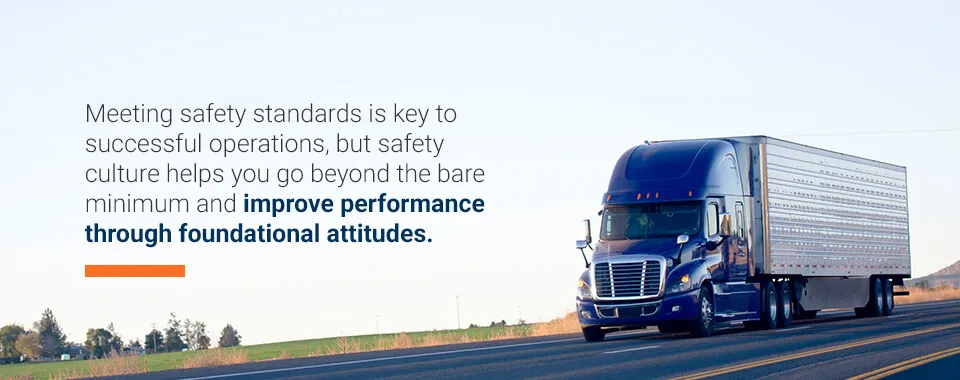

If safety isn’t second nature to every driver in your fleet, you might want to look at the company’s safety culture. Strong safety culture is the backbone of a safe workplace, providing the direction everyone strives to follow. It’s more than just implementing safety policies — it’s about developing the mindsets that drive the business forward. Everything from purchasing decisions to routine inspections should occur within a robust safety policy.
Let’s look at what a strong trucking safety culture can do for your fleet.
Safety culture refers to how people in the company perceive safety. Their values, attitudes and beliefs determine how they behave and whether they prioritize safety during the workday. A crucial part of safety culture is how these ideas fit in every part of the company, from the seasonal help to the CEO.
Is safety at the foundation of administrative decisions, or is it an afterthought? Do employees take precautions to avoid discipline or out of a genuine desire to keep themselves and others safe?
Safety is a foundational part of all business practices in a company with a strong safety culture. It underpins everything the Federal Motor Carrier Safety Administration (FMCSA) and other regulators look for. Violations from these organizations are often symptoms of a much larger, underlying problem — a lack of safety culture in the business. When safety culture is present, violations tend to fall away since the correct, safe processes become foundational to the company’s operations.
A business with trucks depends heavily on its drivers’ behaviors. A significant part of trucking safety culture is addressing driver actions and beliefs, such as education, monitoring and accountability. Other essential parts of trucking safety culture include equipment and process safety. Trucks must be well-maintained to avoid breakdowns or accidents and outfitted with appropriate safety devices. Workplace procedures, like determining routes and conducting inspections, should be performed with safety front and center.
Trucking safety culture looks different for each fleet, but it ensures all employees behave safely, understand why and help others adopt safe behaviors. Poor safety culture has repercussions for the company, its employees and the people they share the highway with.

Safety culture’s importance ripples into virtually every part of the company, offering the following advantages:
Nuclear verdicts — those in which the jury awards $10 million or more — are on the rise, and average verdict costs are up. Safety culture and the robust reporting that comes with it can help you avoid these outcomes and minor settlements that could add up. Companies with strong safety cultures work proactively to prevent these issues, but they’re also prepared if they occur. A safe fleet spends time on maintenance, inspections, hiring and training, all of which provide documentation to support a court case.
An exemplary safety program complete with thorough records and employee buy-in can help you prove your company’s commitment to safety. This information must be in place long before litigation occurs, as anything after that is too little, too late.
Safety culture can also help lower the costs of litigation protection. Most fleets turn to their insurance companies for help during settlements, but coverage can be expensive. Many parts of fleet safety, such as dashcams and smart-tracking technology, can help reduce insurance premiums.
Regulated industries must always be ready for inspections or audits. If you have a strong safety culture, it’s harder to get violations because safety is a major part of the workday. Safe behaviors and procedures are baked into every element of the company, protecting you during audits and helping you avoid them entirely. Typically, something triggers Department of Transportation (DOT) audits. With fewer potential triggers, you lessen your chance of an audit.
A poor safety rating is a significant blow for many fleets. It may also come with civil penalties. A bad enough audit could get a fleet shut down. If not, it might receive a conditional rating to stay operational while fixing the issues. Conditionally rated carriers are often considered less-than-ideal service providers. Many customers won’t do business with them at all, and insurance companies may charge higher premiums.
If you do get audited, your commitment to safety should be ever-present. It can play a significant role in convincing an auditor that your company deserves a good safety rating. Say there’s an incident where a driver’s speed comes into question, but the driver is adamant that he wasn’t driving over the speed limit. A company monitoring speeding behaviors can turn to the driver’s long track record of following the law or the many training modules taken on careful driving to support their case to an auditor.

Meeting safety standards is key to successful operations, but safety culture helps you go beyond the bare minimum and improve performance through foundational attitudes.
The percentage of employees quoting unsafe environments as the reason for leaving is rising faster than those citing other environmental factors. Another popular reason for leaving is a mismatch between the employee and the organizational culture. Improving your safety culture is a great way to address both concerns.
No one wants to go to work every day feeling like they could get hurt on the job. Those people might feel their employer doesn’t care about them and aren’t very attached to the job or the company as a result. Employees can often tell when employers don’t have their best interests at heart, and workers are more than ready to quit their jobs if they aren’t satisfied — “quit rates” are now much higher than they’ve been in the last two decades.
Employee retention is a multifaceted part of business, but making the workplace safe is vital. This goal includes everything from ideas and policies to safe, dependable trucks. Yet safety policies, procedures and trucks aren’t enough. If the workplace is safe, but employees don’t understand or value the reasons behind the safe behaviors, they might feel frustrated and unsure why they perform tasks.
Consider a trucker who is annoyed with her daily inspection. She might see it as a waste of time and fail to assess the truck thoroughly, even though her report has all the right boxes checked. If she knows how her inspection keeps her and other drivers safe, she’s likely to take it more seriously and enjoy the autonomous, active role she plays in fleet safety and health.
Safety culture can extend beyond the workplace. Some businesses implement personal health programs with incentives or resources to support individual health, such as preventative care and weight loss. An employee might learn more about taking care of themselves, allowing them to stay healthier and potentially reduce sick days. Similarly, education about fire safety could help a homeowner protect his house and family, giving him a greater appreciation for his workplace.
If your fleet is working toward continuous improvement, a culture of safety can help. Fleet safety typically involves thorough inspections, reports and assessments to help you identify areas for further improvement. Safety culture can offer a wealth of information to support further safety improvements or other operational goals.
Detailed equipment data could help you spot repair needs sooner or implement more effective maintenance practices based on real-world usage. Administrators conducting regular knowledge checks may identify a gap in understanding and adjust training methods accordingly. Policies rewarding employee vigilance could encourage a driver to come forward with a safety issue. Overall, a culture of safety fosters improvement across many areas of the workplace.
When you tighten your standards and only hire workers with safe records, you also improve overall staff quality. A safety-focused work environment allows these skilled employees to work off of each other, encouraging safe behaviors and fostering a collective positive attitude toward safety. It may even improve team bonding as drivers train and learn to look out for each other. For example, senior drivers might help young recruits learn more about staying safe because they value it and see it as an integral part of the job.
A culture of safety builds on the team’s knowledge and mindset, and a high-quality team is a huge benefit for companies focused on improving every day.
However it’s used, fleet safety culture falls back on employee knowledge. Behind every safe behavior is confidence and appreciation for the task. Employee training can improve performance by developing the skills needed for a task, but company culture also plays a prominent role.

Instilling positive attitudes about safety helps employees feel supported and capable. They can work more confidently and understand the whole picture of safety. When employees understand the “why” of what they’re doing, they’re more empowered to make better, faster decisions.
Say a driver is assigned a specific route but knows he can finish the trip faster by cutting through a busier highway. Without more context, he might take the riskier path, endangering himself and others, or become frustrated with an employer he thinks is wasting time. If he understands safe route planning and why that decision was made, he might happily take the assigned, safer route and contribute to the company’s dedication to safety.
Another way safety culture can help with performance is through a more predictable, efficient workplace and lower accident rates. Safety factors into schedules, protective equipment is standard, and response plans are in place for incidents. Preparation like preventative maintenance software and well-cleaned garages can help stop unexpected injuries and the downtime that comes with them.
Working safely means you frequently reap other benefits of proactive behaviors, like a well-maintained vehicle that runs better or a faster onboarding process.
In short, more predictable, dependable and efficient operations are a byproduct of proactive safety culture.
Stellar safety ratings are excellent for your reputation. They can help you bring in more customers and prove your reliability to your existing partners. Easy compliance and good safety help your customers stay far away from scandals, and fewer incidents mean fewer delays.
Strong safety culture is easy to spot, and it can give you a leg up on the competition.
Many of these benefits translate into lower costs. While investments in safety sometimes seem like extra expenses, they usually offer exceptional returns on investment, something we frequently see in studies. Some ways safety culture might help your bottom line include:
Now that you know just how valuable safety culture can be, you might be ready to make some changes. Fortunately, there are multiple ways you can improve fleet safety. These strategies include establishing incentives, prioritizing maintenance and monitoring driving habits.
Track Your Truck has provided quality fleet safety tools and tracking solutions since 1998, with an extensive catalog of tracking devices and fleet management software to help. From dashcams and vehicle trackers to maintenance, dispatching and monitoring software, our quality solutions can help you pave the way to safer fleet culture. Browse our truck tracking products online, or request a quote to learn more.